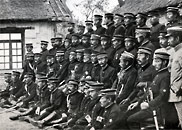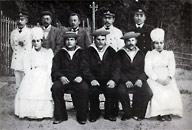
Asia Rising and Yellow Promise/Yellow Peril – Lesson 01b
Learning to Look: How to Read Visual Texts
How to Read a Photograph
Introduction
In this lesson, students are introduced to the concept of visual literacy through photographs of the Russo-Japanese War. Students will be presented with a strategy to approach all visual texts, but will utilize this strategy specifically with photographs. Concentrating on the conscious constructed nature of photographs, students will examine a variety of photographs and then use their knowledge to manipulate photos of the Russo-Japanese War.
Visual Literacy: A Must for the 21st Century
National History Standards
Objectives
At the conclusion of this activity, students will be better able to:
1. Understand photographs as a constructed means of communication.
2. Understand photographs as an important medium for communication of the events of the Russo-Japanese War.
3. Utilize the Five C’s as a strategy for reading visual texts—in this case photographs.
Time Required
One class period
Materials and preparation
Monitor/projection device
Copies of Photograph 1b for each student
How to Read a Photograph (PowerPoint)
Procedure:
1. Ask students why they personally take photographs. Remind students that professional photographers take photographs for a wide variety of reasons. Generate a list of reasons people take photographs today.
2. Ask students to consider the impact of photography when it was first introduced. How do students think this technology changed the way people viewed the world?
3. Show the following photograph from the Russo-Japanese War to students.
A: 
Remind the students of the list they just generated of the reasons people take photographs. Ask the students why they think this particular photograph was taken. What could have been the photographer’s reason? If the photographer wanted to capture the moment, then what moment is actually being captured here, and why?
4. If you have not already introduced the students to the Five C’s in Part 01A of this lesson, do so here. Tell students that this is a consistent strategy for reading visual texts. Instruct students that the purpose of this lesson is to consider the Five C’s, but we will concentrate on the last one—the conscious construction of photographs. Students will be considering this last point through a visual presentation.
5. Instruct students to “read” the photo they looked at in Step Three of this lesson but this time they should use the Five C strategy.
6. Although many of us consider photos more “realistic” than other visual constructions, photographs are consciously constructed for a purpose. Instruct students that the purpose of this lesson is to consider the 5th C here—Construction. They will be considering this last point through a visual presentation.
8. Direct students to the last slide of the PowerPoint.
B: 
Inform students that this is a photograph of Russian POWs and the Japanese taking care of them. Individually, students should use the Five C’s to better understand the “meaning” and “message” of this photograph. Instruct students to write down that meaning in their notebooks.
9. Distribute a hard copy of this photograph (1b) to each student. Instruct the students to frame or crop the photo in a different way to give it new meaning. Students can either use scissors or simply fold the paper to frame the photograph in a new way.
10. Gallery Walk. Present each individual’s new photograph through a gallery walk. Hang each photograph around the room. Students should view each text trying to use the Five C’s.
11. Discuss as an entire class:
• How was the original purpose of this photograph altered?
• How many different “messages” or “meanings” became possible simply by framing the photograph in a different way?
• How “realistic” are photographs?
12. Exit Card Strategy. In order to ascertain what individual students understood about the lesson, teachers may choose to use the exit card strategy. Teachers should give each student an index card. Tell the students to answer the following questions briefly on the index card.
What was the most important visual literacy strategy you learned today?
What one question do you have?
What would you like to know more about?
Students should complete their answers and hand the cards to the teacher before exiting.
Massachusetts Institute of Technology © 2008 Visualizing Cultures



